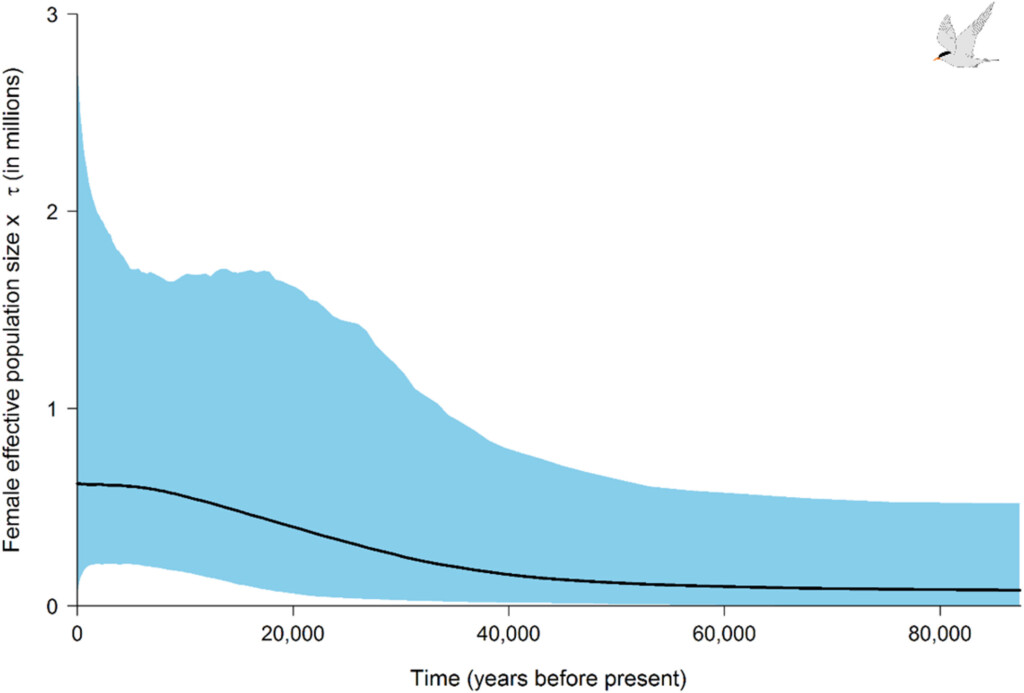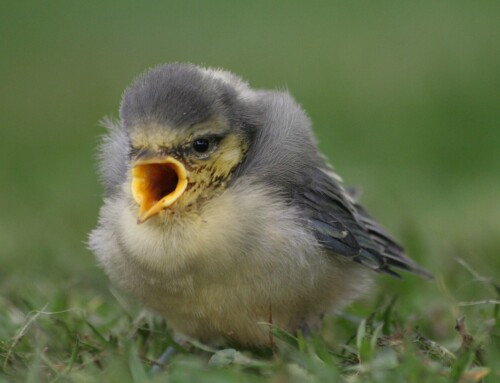
LINKED PAPER
New Zealand endemic open-habitat specialist, the Black-fronted Tern (Chlidonias albostriatus), experienced population expansion during Pleistocene glaciation and recent decline. Schlesselmann, A. K. V., Cooper, J., Dussex, N., Robertson, B. C. 2023. IBIS. DOI: 10.1111/ibi.13107. VIEW
New Zealand has experienced some of the highest extinction rates of birds in the world, with around 80 of 230 lineages becoming extinct since human settlement (Holdaway 1999, Brooks et al. 2002), and many extant endemic species classified as threatened. By understanding how climatic and environmental changes, along with human activities, have led to historical changes in distribution and population size of bird species, we can better predict potential future impacts and assess the vulnerability of species to global change.
In a recent study in Ibis, Ann-Kathrin V. Schlesselmann and colleagues used multilocus genetic data to reconstruct past demography of Black-fronted Terns (Chlidonias albostriatus) in New Zealand.
New Zealand biogeography and human impacts
In New Zealand, during the last glacial period (73,000-14,000 years ago) terrestrial land area, such as river braid plains, expanded, and lowland areas around Te Waipounamu (the South Island) were dominated by dry grasslands with some shrubs and small pockets of forest (Newnham et al. 2013, Mortimer et al. 2017). During the Holocene, the climate warmed, resulting in closed-canopy forests expanding to cover 85-90% of New Zealand (McGlone 1989). The arrival of Polynesian settlers in the 13th century, followed by European colonisation from the 19th century, led to a loss of forest through burning and clear-felling, and forest now covers ~25% of New Zealand land surface (Perry et al. 2014). While this could potentially be beneficial for open-habitat specialists, such as Black-fronted Terns, other anthropogenic impacts such as introduction of exotic flora and fauna have also led to declines in native species.

Figure 1. Demographic history of Black-fronted Terns over the last 85 000 years modelled from an extended Bayesian skyline plot based on Cytochrome b (1143 bp) and Control Region (898 bp) sequences from throughout their range. The female effective population size (Nef) * generation length (τ) is shown on the y-axis and time in years before present on the x-axis. The solid line indicates the median estimate and the shaded area the 95% highest posterior density interval.
Population expansion and decline
The results revealed multiple lines of evidence supporting a population expansion in Black-fronted Terns during the last glacial period (20,000-55,000 years BP). The data further suggest that other open-habitat specialist birds in New Zealand may also have experienced range expansion during glacial periods. A human-induced decline in Black-fronted Tern population size is found to be likely, as several estimates of the timing of population decline based on the range of plausible Black-fronted Tern generation lengths suggest there was a reduction in population size after colonisation by humans and their commensal species. The constraint of populations by predators independent of habitat availability has also been seen in other island endemic species. While the results did not consistently support a recent bottleneck, findings from other studies indicate that this may be due to the relatively large size of the surviving population, although still experiencing range-wide decline.
This is the first study of an open-habitat specialist bird in New Zealand to test for habitat-induced population expansion during Pleistocene glaciation. The researchers suggest that future work could use whole genomes to increase inferential power, and should focus on developing theoretical foundations for past and present range expansions taking into consideration ecologies and ecological communities to provide further insights into environmental and anthropogenic drivers of demographic history.
References
Brooks, T.M., Mittermeier, R.A., Mittermeier, C.G., Da Fonseca, B.G.A., Rylands, A.B., Konstant, W.R., Flick, P., Pilgrim, J., Oldfield, S., Magin, G. & Hilton-Taylor, C. (2002). Habitat loss and extinction in the hotspots of biodiversity. Conservation Biology 16: 909–923. VIEW
Holdaway, R.N. (1999). Introduced predators and avifaunal extinction in New Zealand. In MacPhee, R.D.E. (ed) Extinctions in Near Time. Causes, Contexts, and Consequences: 189–237. New York, NY, USA: Springer Science+Business Media LLC. VIEW
McGlone, M.S. (1989). The Polynesian settlement of New Zealand in relation to environmental and biotic changes. New Zealand Journal of Ecology 12: 115–129. VIEW
Mortimer, N., Campbell, H.J., Tulloch, A.J., King, P.R., Stagpoole, V.M., Wood, R.A., Rattenbury, M.S., Sutherland, R., Adams, C.J., Collot, J. & Seton, M. (2017). Zealandia: earth’s hidden continent. GSA Today 27: 27–35. VIEW
Newnham, R., McGlone, M., Moar, N., Wilmshurst, J. & Vandergoes, M. (2013). The vegetation cover of New Zealand at the last glacial maximum. Quaternary Science Reviews 74: 202–214. VIEW
Perry, G.L.W., Wilmshurst, J.M. & McGlone, M.S. (2014). Ecology and long-term history of fire in New Zealand. New Zealand Journal of Ecology 38: 157–176. VIEW
Image credits
Top right: Black-fronted Tern (Chlidonias albostriatus) | JJ Harrison | CC BY-SA 4.0 Wikimedia Commons
Blog posts express the views of the individual author(s) and not those of the BOU.
If you want to write about your research in #theBOUblog, then please see here





